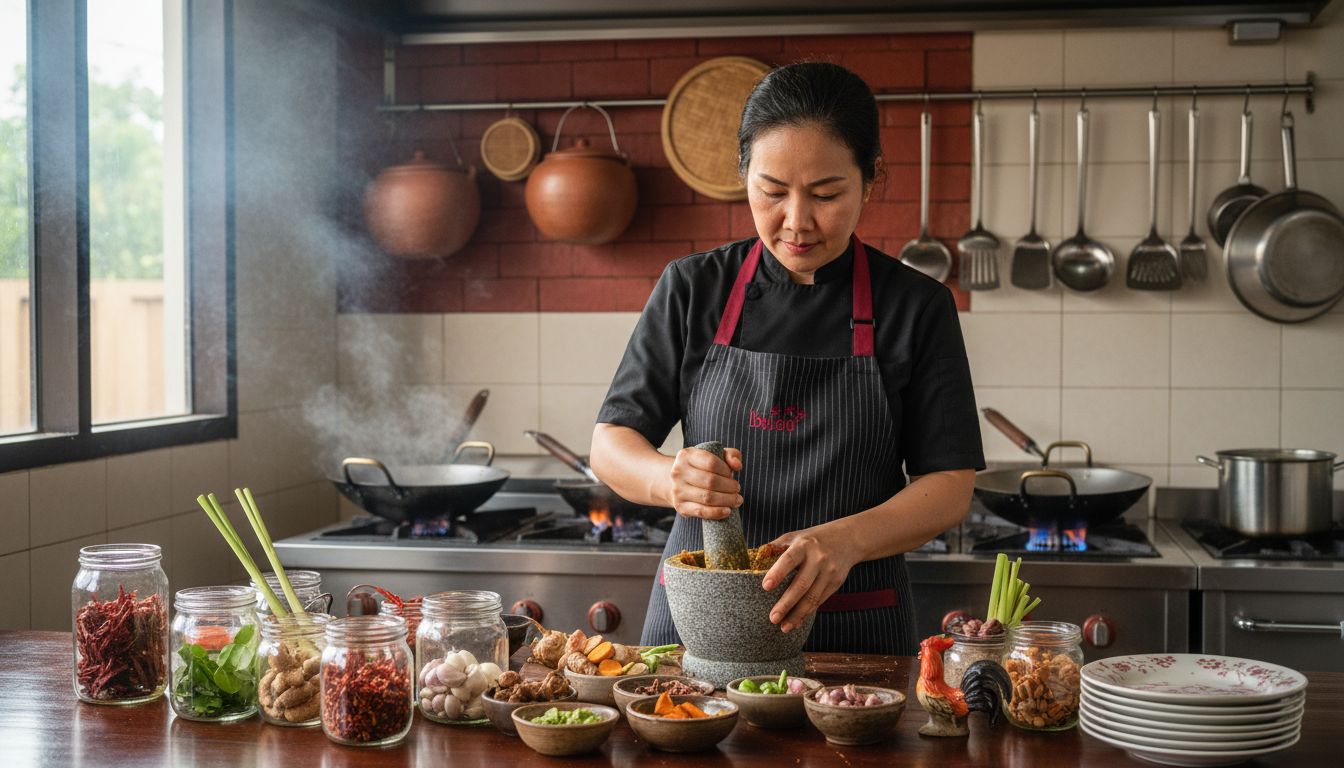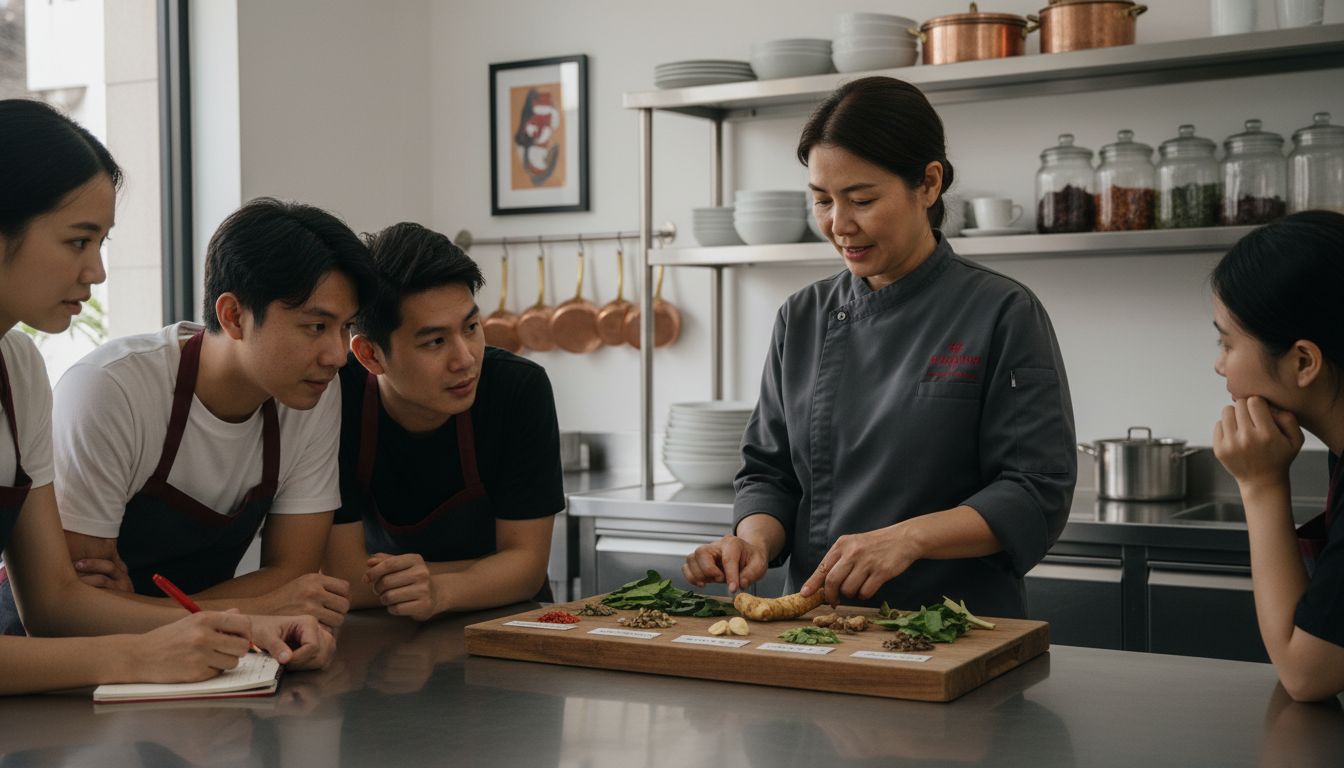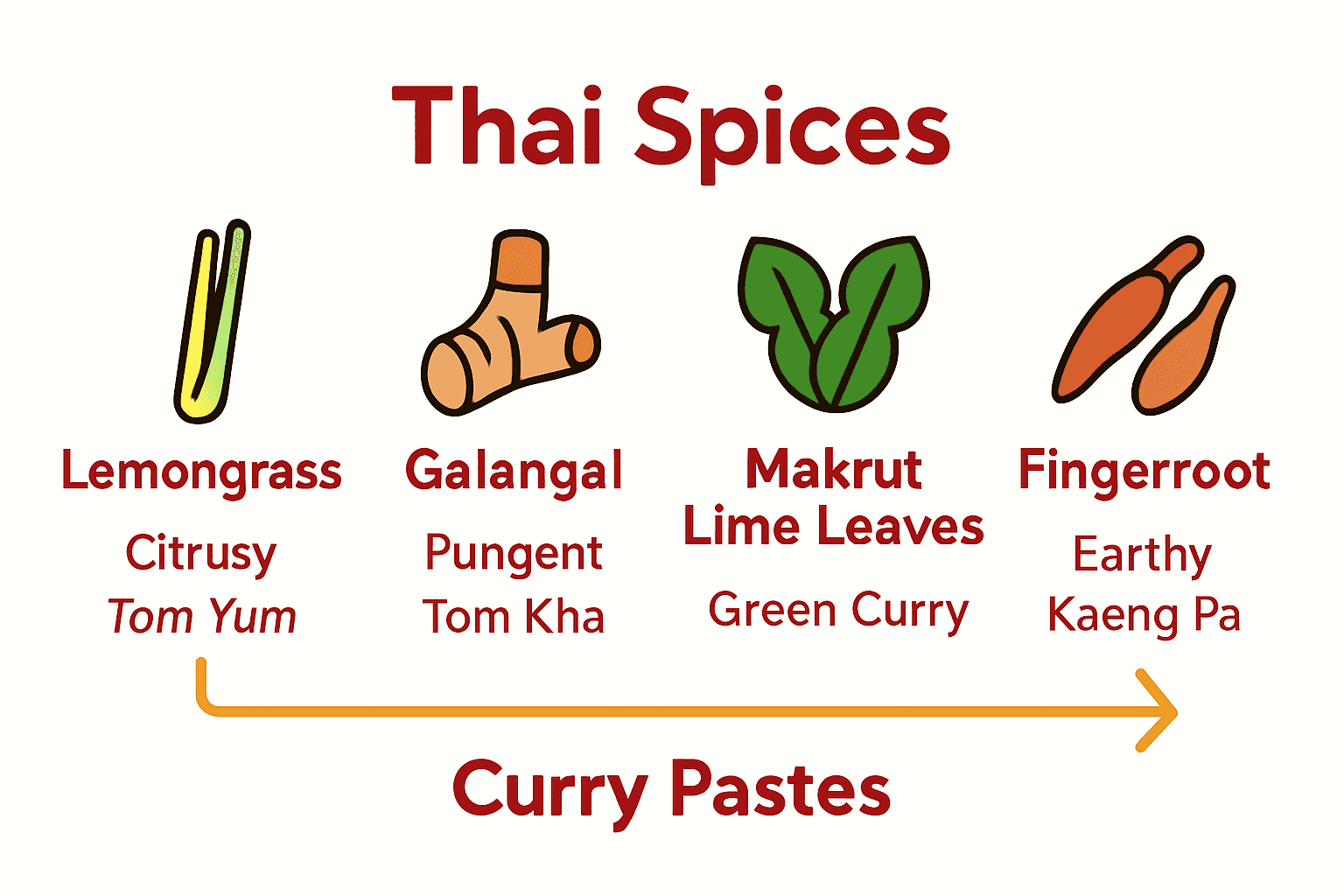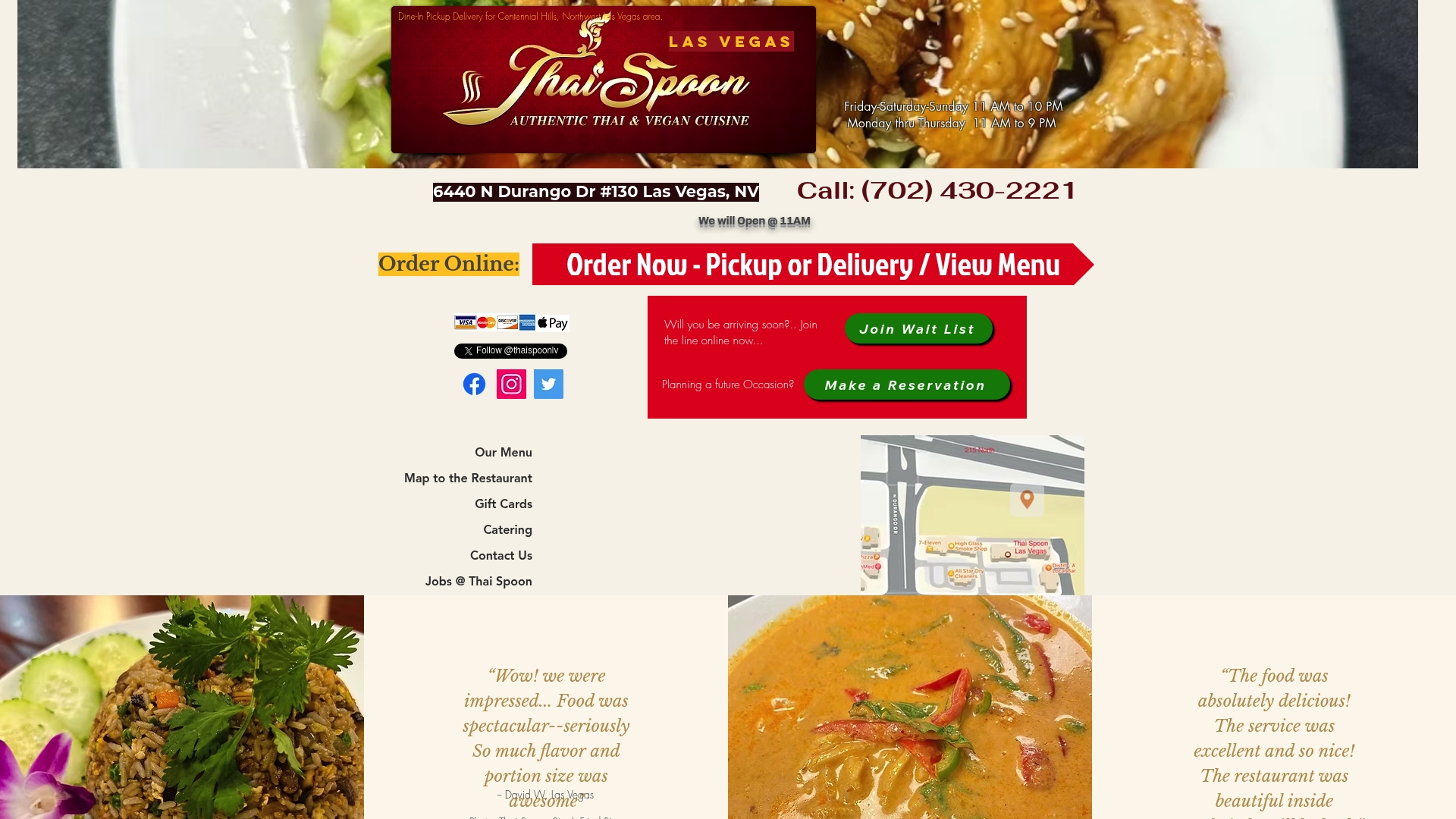The Essential Guide to Spices in Thai Food
- mail469793
- 4 days ago
- 6 min read

Nearly every unforgettable Thai dish owes its magic to the careful use of spices, which transform everyday ingredients into vibrant blends of flavor. Studies show that the right combination of aromatics is vital for achieving the signature sweet, salty, sour, and spicy notes that define Thai cuisine. By exploring how spices bring dishes to life and what makes their balance so unique, you can discover the secrets behind some of the world’s most beloved food traditions.
Table of Contents
Key Takeaways
Point | Details |
Role of Spices | Spices are essential in Thai cuisine, creating complex flavor profiles through effective blending and preparation methods. |
Key Spices | Notable spices like lemongrass, galangal, and makrut lime leaves contribute distinctive tastes to authentic Thai dishes. |
Flavor Dynamics | Successful Thai cooking hinges on balancing sweet, sour, salty, and spicy elements to achieve a harmonious flavor experience. |
Avoiding Mistakes | Proper usage of spices is crucial; common errors, such as incorrect quantities and neglecting fresh ingredients, can ruin a dish’s intended flavor. |
Defining the Role of Spices in Thai Cuisine
Spices are the heartbeat of Thai cuisine, transforming simple ingredients into vibrant culinary experiences. According to Thailand Foundation, spices and aromatics are fundamental, contributing to the iconic balanced taste through various preparation methods like garnishing and direct infusion.
The magic of Thai spices lies in their ability to create complex flavor profiles. Spice blends are often ground into intricate pastes that serve as the foundation for soups, curries, and stir-fries. As Innovation Thailand explains, Thai cuisine is renowned for achieving an intricate balance of sweet, sour, salty, and spicy tastes that define the culinary experience.
Key characteristics of Thai spice usage include:
Creating multi-dimensional flavor layers
Balancing contrasting taste sensations
Using fresh and dried spice combinations
Developing unique regional flavor signatures
Understanding these spice dynamics can help you appreciate the depth and artistry behind Thai cooking techniques. The careful selection and preparation of spices is what elevates Thai dishes from mere meals to sensory journeys that delight and surprise the palate.
Key Spices Used in Authentic Thai Dishes
Authentic Thai cuisine is a complex symphony of flavors, with spices playing a pivotal role in creating its distinctive taste profile. According to SO02, essential spices in Thai cooking include lemongrass, galangal, makrut lime leaves, and fingerroot, each contributing unique and vibrant characteristics to traditional dishes.
The intricate world of Thai spices extends far beyond simple seasoning. Curry pastes are particularly remarkable, with SO01 highlighting how herbs and spices like Heracleum siamicum Craib create the distinctive flavors found in classic dishes such as gaeng massaman and gaeng khiao wan. These spice combinations are not just about heat, but about creating a harmonious balance of flavors.
Key authentic Thai spices include:

Lemongrass: Citrusy and bright
Galangal: Sharper and more peppery than ginger
Makrut Lime Leaves: Providing intense aromatic notes
Fingerroot: Adding unique earthy undertones
For those eager to explore these flavor profiles in depth, our signature Thai spices guide offers an extensive look into the spices that make Thai cuisine a global culinary treasure.

How Spices Shape Thai Food’s Flavor Profile
The art of Thai cuisine is fundamentally rooted in its extraordinary ability to balance complex flavor sensations. According to Thailand Foundation, the masterful use of spices and aromatics creates a harmonious taste by meticulously combining elements like sweetness, spiciness, and bitterness, resulting in incredibly nuanced culinary experiences.
Chili peppers emerge as particularly transformative ingredients in this flavor landscape. Culinary Quests highlights that Thai chili peppers do more than just add heat—they provide profound depth to dishes and symbolize cultural strength and resilience. These peppers are not merely ingredients, but storytellers of Thai culinary tradition.
Key flavor-shaping techniques include:
Balancing contrasting taste elements
Layering aromatic spices
Creating multi-dimensional taste experiences
Using heat as a flavor conductor
To truly understand how these flavor dynamics interplay, our guide to authentic Thai flavors offers an in-depth exploration of the culinary principles that make Thai cuisine a global sensation.
Common Mistakes When Using Thai Spices
Mastering Thai spices requires precision and understanding. According to Thailand Foundation, improper use of key ingredients like lemongrass and galangal can disrupt the delicate balance of flavors essential to authentic Thai cuisine. This means that even a small misstep can transform a potentially remarkable dish into a culinary disappointment.
Spice quantity is particularly critical. Culinary Quests emphasizes that misjudging the amount of Thai chili can result in dishes that are either frustratingly mild or overwhelmingly spicy, completely derailing the intended flavor profile.
Common spice mistakes to avoid include:
Overusing or underusing key aromatic spices
Failing to understand each spice’s unique flavor contribution
Neglecting the importance of fresh ingredients
Ignoring the principle of flavor balance
For those looking to elevate their Thai cooking skills, our 7 essential tips for Thai food beginners can help you navigate the complex world of Thai spices with confidence and creativity.
Health Benefits and Modern Uses of Thai Spices
Thai spices transcend mere culinary applications, emerging as powerful natural wellness ingredients. According to SO01, Thai herbs and spices like Heracleum siamicum Craib are packed with high vitamin content and phytonutrients, offering substantial health benefits alongside their remarkable flavor profiles.
Medicinal spices represent a fascinating intersection of traditional wisdom and modern health research. SO02 highlights that spices such as galangal and fingerroot possess significant medicinal properties, contributing not just to taste but to holistic well-being. These ingredients are increasingly recognized in contemporary nutrition and wellness circles for their potent health-enhancing qualities.
Modern health benefits of Thai spices include:
Supporting immune system function
Reducing inflammation
Enhancing digestive health
Providing antioxidant protection
Promoting metabolic balance
To dive deeper into the rich cultural and health dimensions of these remarkable ingredients, explore our guide to what makes Thai cuisine unique, which offers comprehensive insights into the holistic significance of Thai culinary traditions.
Discover the True Taste of Thai Spices with Every Bite
Understanding the delicate balance and unique character of Thai spices can be challenging. The right blend brings out complex flavors without overpowering the dish. If you have ever struggled with getting this balance just right or want to experience how authentic Thai spices shape unforgettable flavors, Thai Spoon Las Vegas offers a genuine solution. From freshly prepared curry pastes to perfectly seasoned dishes, each meal reflects the artistry of Thai spices explored in this guide.

Experience the vibrant aromas and flavors you have read about by visiting Thai Spoon Las Vegas. Whether you prefer to dine in, pick up, or get delivery, you can savor traditional dishes like Pad Thai or Yellow Curry crafted with care and precision. Ready to elevate your Thai food experience? Explore our menu and discover how expert use of spices transforms every dish. Take the next step and taste the perfect harmony of Thai spices today.
Frequently Asked Questions
What are the key spices used in Thai cuisine?
Key spices in Thai cuisine include lemongrass, galangal, makrut lime leaves, and fingerroot. Each of these spices contributes unique flavor profiles that elevate traditional dishes.
How do Thai spices shape the flavor profile of dishes?
Thai spices create a balanced and complex flavor experience by combining elements of sweetness, spiciness, sourness, and saltiness. Techniques like layering aromatic spices are crucial for developing multi-dimensional tastes.
What are common mistakes to avoid when using Thai spices?
Common mistakes include overusing or underusing key spices, failing to recognize the unique contributions of each spice, and neglecting the significance of using fresh ingredients. Maintaining flavor balance is essential for authentic Thai cooking.
What health benefits do Thai spices offer?
Thai spices such as galangal and fingerroot are noted for their health benefits, including supporting the immune system, reducing inflammation, enhancing digestive health, and providing antioxidant protection.
Recommended











Comments